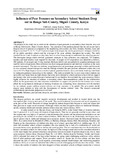| dc.description.abstract | The purpose of this study was to establish the influence of peer pressure on secondary school students’ drop out in Rongo Sub-County, Migori County, Kenya. The statement of the problem showed that the sub-county had a dropout rate of 43 percent as compared to the neighboring sub counties like Uriri, Awendo, Nyatike, Kuria and Migori which had 25, 9, 27, 23 and 28 percent respectively despite the similar government’s strategies availed to all the public secondary schools and the coverage of the same syllabus throughout the country. The study involved forms 3 and 4 students as they have been in school long enough to understand the schooling process.
The descriptive design which involved qualitative strategies to data collection was employed. 755 students, teachers and head teachers were targeted for the study. A sample of 235 respondents was identified as follows, 200 students, 20 principals and 15 class teachers. Both probability and non-probability sampling techniques were used for various respondents. Data collection was done using questionnaires and interview schedules as the main research instruments. The data was analyzed using frequencies and percentages presented in tables and discussed. A cross sectional research design was used the findings revealed that peer pressure influenced student drop out was at 43.75%. High dropout was as a result of parent/ guardian financial status and family headship which lead to inadequate guidance/ mentorship to the students. The study concluded that in most cases where students are most often sent home there are high chances that some never returned to school and most schools did not support the learners who were coming from poor background. It can therefore be concluded that socio-economic factors highly influence the retention of students in secondary school. Recommendations called for the collaborative efforts by the government and other education stakeholders to support and provide for the learners who cannot afford the rising financial challenges of learning. Guidance and counseling, close interactions with the teachers
by the students, proper syllabus content delivery are other measures to be upheld. The government should employ more teachers to help curb the discrepancies of teacher students’ ratio. The research considered confidentiality and avoided plagiarism of any kind. | en_US |

